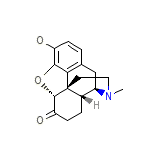Dihydromorphinone




Dihydromorphinone Brand names, Dihydromorphinone Analogs
- DiMo
- Dihydromorfinon
- Dihydromorfinon [Czech]
- Dihydromorphinone
- Dilaudid
- Dilaudid Oros
- Dilaudid-hp
- Dimorphone
- Hidromorfona [INN-Spanish]
- Hydromorfona [Spanish]
- Hydromorphon
- Hydromorphone HCL
- Hydromorphonum [INN-Latin]
- Hymorphan
- Idromorfone
- Idromorfone [DCIT]
- Laudacon
- Laudicon
- Morphinone, dihydro-
- Novolaudon
- Palladone
- Paramorphan
Dihydromorphinone Brand Names Mixture
- No information avaliable
Dihydromorphinone Chemical_Formula
C17H19NO3
Dihydromorphinone RX_link
http://www.rxlist.com/cgi/generic/hydromorphone.htm
Dihydromorphinone fda sheet
Dihydromorphinone msds (material safety sheet)
Dihydromorphinone Synthesis Reference
No information avaliable
Dihydromorphinone Molecular Weight
285.338 g/mol
Dihydromorphinone Melting Point
266-267 oC
Dihydromorphinone H2O Solubility
No information avaliable
Dihydromorphinone State
Solid
Dihydromorphinone LogP
1.28 (Roy, SD; Flynn, GL Pharm. Res. 5:580 (1988))
Dihydromorphinone Dosage Forms
Capsule (controlled-delivery); Solution; Tablet
Dihydromorphinone Indication
For the relief of moderate to severe pain such as that due to surgery, cancer, trauma/injury, burns, myocardial infarction and colic.
Dihydromorphinone Pharmacology
Hydromorphone is a hydrogenated ketone derivative of morphine that acts as a narcotic analgesic. It has a shorter duration of action than morphine. Hydromorphone is approximately 8 times more potent on a milligram basis than morphine. In addition, hydromorphone is better absorbed orally than is morphine. In clinical settings, Hydromorphone exerts its principal pharmacological effect on the central nervous system and gastrointestinal tract. Its primary actions of therapeutic value are analgesia and sedation. Hydromorphone appears to increase the patient's tolerance for pain and to decrease discomfort, although the presence of the pain itself may still be recognized. In addition to analgesia, alterations in mood, euphoria and dysphoria, and drowsiness commonly occur. Opioids also produce respiratory depression by direct action on brain stem respiratory centers.
Dihydromorphinone Absorption
Better absorbed orally than morphine
Dihydromorphinone side effects and Toxicity
Hydromorphone is a schedule II narcotic which can lead to physical dependence or addiction. High doses lead to respiratory depression, nausea, and vomiting. Overdoses lead to extreme somnolence progressing to stupor or coma, skeletal muscle flaccidity, cold and clammy skin, and sometimes bradycardia and hypotension. In severe overdosage, apnea, circulatory collapse, cardiac arrest and death may occur.
Dihydromorphinone Patient Information
http://www.drugs.com/cons/Hydroflumethiazide.html
Dihydromorphinone Organisms Affected
Humans and other mammals














